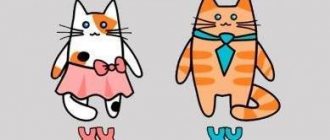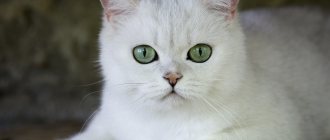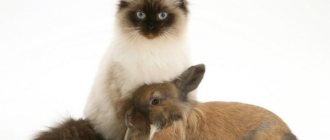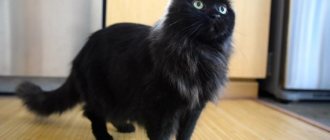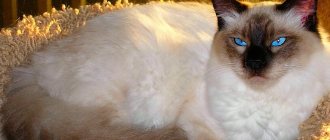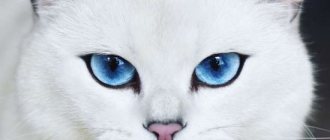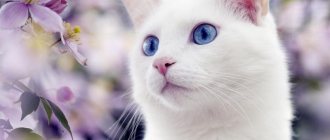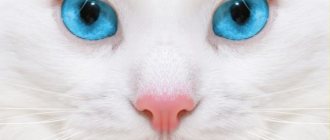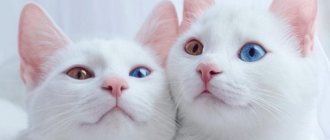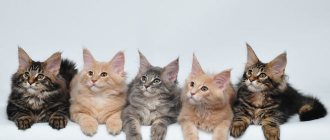Black cats with blue eyes look noble. Even no less noble than the snow-white beauties. Therefore, they are worth learning more about these coal-black beauties, including the difficult fate that befell them because of their black color.
Blue eye color has always attracted the attention of breeders. Well, as for black cats with blue eyes, they seem to be some kind of magical, mystical creatures, which aroused more and more interest among some people, and superstitious fear among others. However, if you yourself are not the source of harm to the cat, there is no reason to be afraid of it.
Black color in various combinations is present in almost all breeds. But before, and even now at times, absolutely black cats are unlucky, and they are accused of everything, trying to avoid them.
Although for the Egyptians these animals were considered sacred, in the Middle Ages they were less fortunate - black cats were burned at the stake along with “sorcerers” and “witches”.
Many scientists are of the opinion that it was black cats that were the ancestors of today's pets. In addition, their black coloration gives them an advantage when hunting at night, which likely contributed to their high prevalence and survival rate.
Genetics of black color
Many Internet pages are full of photographs of black cats. What gives these animals such a beautiful color? The pigment eumelanin, which is responsible for the formation of black color, is responsible for this. This pigment is present in the cat’s hair in the form of granules, and the shade of the cat’s color depends on what shape they are, how much they are contained and where they are located. For example, the rich black color of the coat is given by the B (Black) gene in a dominant state. In this case, the eumelanin granules have a slightly elongated shape at the poles and are placed very tightly. In other, recessive conditions, the gene contributes to the appearance of calmer shades. Thus, species b pulls out pigment granules and separates them over long distances, resulting in a chocolate color. And the bl form further expands and moves the granules away from each other, resulting in a cinnamon color.
In most cases, black cats give birth to black kittens.
Perfect black cats are rare. At least minimally lightened areas are still present on the body, but they are often very well hidden and not noticeable.
Black cats are not a separate class. This color can be found in any breed. But blue eyes among them are a very rare phenomenon. Here are some of the cases where black cats have been observed to have blue eyes:
Bombay
Oriental
Canadian Sphynx
What determines the white-blue-eyed combination?
Snow-white fur in cats is also not a very common color in nature. There are three main reasons why a cat may have blue eyes:
- Gene dominance. The gene that provides the animal with a snow-white color often also becomes the cause of the cornflower blue color of the iris. The chance of an unusual iris color is the same for pure white pets and for those in which white predominates in the overall color. However, gene activity usually reduces hearing acuity, sometimes to the point of complete deafness.
- Genetic code of albinos. In cats, albinism manifests itself in the form of white fur combined with aquamarine eyes.
- The color of the fur on the face. Cats that have white spots on their faces around their eyes are more likely to have blue irises.
For the same reasons, cats have eyes of different colors. Kittens are always born with gray or blue eyes, which change color as the pet grows older.
Blue-eyed black cats - Ojos Azules
Ojos Azules is the only breed that combines black coat color and blue eyes, not as a huge exception. At first these cats had a tortoiseshell color, but after numerous crossings individuals with black fur were obtained.
Temperament and behavior
These cats are very calm and attached to their owner. They love attention, but will not attract it too intrusively and distract others from their work. Okhs cannot spend time without the company of their owner for a long time, but they are not entirely sociable with other pets. They love to play and when interacting with children they are not dangerous to them (of course, until they consider the children themselves dangerous to themselves - in this case, they will undoubtedly defend themselves without regard to the age of the person in front of them).
Features of care
It is enough to brush cats of this breed several times a month, because although they can have both long and short hair, at the same time they have a sparse undercoat. In addition, it is important to trim the claws on time, firstly, so that the cat does not hurt itself, and secondly, so that it does not start sharpening them on everything it sees if there is no scratching post.
Health
The most important feature of the breed, which should not be forgotten, is that representatives of this breed cannot be crossed with each other, as well as with other breeds if they have blue eyes - there is a high risk of sick, inferior or even dead offspring. In other cases, there is no need to worry, since representatives of the Ojos Azules breed have good immunity and good health. At the moment, no diseases characteristic of her have been identified. With proper nutrition and care, they can live up to seventeen years, and in some cases longer.
Sacred Burma, Ragdoll and Ragamuffin
These breeds have family ties, when compared with human ones, like grandmothers, daughters and granddaughters: the Burmese cat is the “primary source” from which ragdolls and ragamuffins originated. Moreover, if the Burmese and Ragdoll have blue eyes, then the Ragamuffins can have them of any color; blue and dark blue are simply more common.
The Burmese cat is an ancient Tibetan breed, whose representatives lived in monasteries and were considered the reincarnation of the souls of deceased monks. Their distinctive feature is white “socks”, which are not typical for Thai and Siamese cats, which Burmese cats resemble.
According to legend, “sacred Burma” acquired them as a result of a miracle - when a cat, guarding a golden statue in a temple, jumped on the head of a harrier-haired monk. The whiteness of his hair was transferred to her paws, and since then all representatives of the breed have worn this insignia.
Ragdolls, descended from Burmese and Persians, are distinguished by a very even and non-militant disposition. In the hands of a person, they completely relax and are very loyal to the caresses of their owners, hence the name, which means “rag doll”.
The breed became so popular due to its gentle character and charming appearance that breeders decided to increase the number of such cats and diversify their colors, so they began to cross Ragdolls with outbred cats, selecting kittens of interesting colors for breeding. This is how the ragamuffins (“ragamuffins”, English - Ed.) appeared. Their eye color is often blue and blue, but for some Ragamuffin colors (such as sepia) this is not allowed.
Rules for caring for black fur
Black fur can fade in the sun, so if you want to maintain the jet black color of your cat's fur, you need to control the amount of time he is exposed to direct sunlight.
Black wool partly requires a special approach. So, you should not let your cat walk for a long time under the scorching sun, as the fur may fade and red spots will appear on the fur coat.
A cat's fur is an indicator of its health. If the fur coat begins to fade and fall out a lot, you should reconsider your pet’s diet and show it to the veterinarian.
Otherwise, the rules of nutrition and care are generally similar for all types of cats, but you need to follow the care features of each breed. For example, Manx cats have a thick undercoat, and therefore need to be combed thoroughly, but bathed no more than twice a year, using special shampoos and conditioners to enhance shine. Maine Coons need to be brushed at least once a week, while Persians and Siberians with long hair require special care. They need to be combed daily in three stages: first with a wide-toothed comb, then with a slicker brush, and finally with a fine-toothed comb. You can bathe them four times a year, after which you treat the wool with a special product to make combing easier.
Nutrition
An important aspect of caring for Scottish Folds is food. Nutrition should be regular and balanced so that the pet is always strong. The best option is a harmonious diet based on natural ingredients.
You can also choose good bagged food. Experts and nurseries recommend a varied diet that contains both natural ingredients and cat food. You should always remember to drink regularly.
The water in the bowl should be renewed daily, no matter how much you drink. It is normal for adults to eat 2-3 times a day. You should not change the types of food frequently, so as not to get a stomach ache.
It should be remembered that cats are contraindicated from eating foods with a lot of fat, with vinegar and salt, fried foods and containing sugar. Seasonings and hot and cold foods should be avoided.
Good for Scottish Folds:
- lean meat;
- fish;
- milk;
- cottage cheese.
Vegetable ingredients, fresh and boiled, and all sorts of cereals are needed.
It is not advisable to give:
- eggplant;
- tomatoes;
- onion;
- garlic.
Myths and signs about black cats
Many myths and superstitions about black cats originated in the dark era of the Middle Ages. And the attitude towards them was, to put it mildly, unkind. Black cats were considered carriers of misfortune and disease, the reincarnation of bad people, messengers of troubles and misfortunes, and during a thunderstorm these poor fellows were kicked out into the street so that they would not attract lightning to the house.
In honor of the animals that were killed during the Inquisition, Italian animal activists have introduced a new holiday for black cats. It is celebrated annually on the seventeenth of November.
However, it is gratifying that there were much fewer such prejudices than positive signs and beliefs associated with black cats. For example, in Egypt they were considered messengers of the goddess Bastet and symbols of moonlight. Among the Celts, black cats were identified with Artemis (goddess of the hunt), and among the Romans - with Diana (goddess of fertility), and even today. Also, the presence of these cats in a home in Ireland promises good luck, in Scotland - wealth, in England - admirers, and in Russia - protection from thieves (not surprising, since many cats quite fiercely defend their territory). And sailors happily take cats on a voyage, and if she is black, the trip promises to be successful.
Temperament and behavior
No matter what breed a black cat belongs to, it will always be sociable and cheerful. Owners of such pets note their openness and loving nature. These animals get along well with children and generally get along with everyone in the household.
Black cats are active, playful and do not like to sit in one place for a long time. They prefer to spend time actively; they simply need to move. As a kitten, an animal in a dark fur coat will endlessly chase a ball, and as it grows up, it will begin to switch to larger objects. With age, black cats' hunting instinct becomes more intense, and their physical activity only increases from this.
What is special about blue eyes
As a rule, in his life a person meets cats that are distinguished by a yellow iris, but one cannot be surprised by the presence of an amber tint or green eyes. Eyes of blue or deep blue color - this phenomenon is rare, although not exceptional. Blue eye color can be considered some distinctive feature of various breeds. When felinologists describe the breed, they indicate that blue eye color is preferred, although other shades are also allowed. It is known that nature is distinguished by its uniqueness, therefore there are individuals with different eye colors. Moreover, there are eyes when one iris consists of two shades that do not mix with each other.
The color of an animal's eyes is related to genetic background. After kittens are born, they open their eyes only after a couple of weeks. At the same time, the eye color is always blue. Experts believe that blue eye color is associated with a lack of melanin, which is responsible for the color of the pigment. When the kitten’s own cells begin to produce melanin, it is already too late, because until that moment the kitten’s body ate what its mother could provide it with.
When a kitten begins to grow and develop, its body begins to produce all the necessary components for life. As a result, the eye color may change and take on the color of its parents. In fact, the body does not always repeat exactly everything that is characteristic of its parents. In connection with this fact, it is worth noting that this is what makes our world so diverse.
In some kittens, the body fully produces coloring pigment, so the color may be more saturated, darker. Some individuals have enough pigment to have normal yellow or greenish eyes.
In kittens with a predominant white tint, who are carriers of the albino gene, this pigment is only enough to make their eyes blue. Often such breeds are born with different eyes. Many people don’t know, and don’t really think about the fact that the reason for everything is a lack of coloring pigment, which is directly related to the level of melanin.
For some reasons, blue eye color indicates various congenital defects or pathologies. In fact, this is not so and the presence of blue eyes is not evidence of the presence of any disease, especially of a genetic nature. In addition to blue eyes, these pets retain all the basic characteristics of cats: acute hearing and vision, a cheerful playful disposition, a desire to hunt, etc.
Interesting to know! It is believed that all-white cats, distinguished by blue eyes, have poor hearing. Unfortunately, this is a myth, since the presence of hearing has nothing to do with eye color. At the same time, about 5% of white cats are indeed somewhat deaf, but this is within the acceptable range.
In any case, when purchasing a white cat (or any other), it doesn’t hurt to have his eyesight and hearing checked. In this case, you need to know that a pet with hearing and vision problems simply will not survive without a person. Therefore, you must always be close to him and not leave him unattended.
When eye color begins to change after some time in life, then special attention should be paid to this fact, since it can be very serious. This may indicate that your pet has begun to develop a serious illness.
Many people attribute magical abilities to cats with blue eyes, are afraid of these cats or expect miracles from them. What the future offspring will be like depends on the genetics of the family, and all we can do is witness the fact of this miracle, protect it and take care of it.
Those owners who love and care for their pets always produce irresistible beauties that evoke surprise and admiration.
The black cat is an animal that evokes admiration and fear at the same time. In ancient times, cats with black fur were feared and considered fiends of hell, accomplices of witches and sorcerers. Meeting a black cat is still considered a harbinger of trouble. But do these wonderful animals deserve such treatment? Felinologists claim that the fear of black cats is completely unfounded, and their disposition is much more docile than that of most felines.
Breeds not included in the top ten most famous
Among the variety of cat breeds with blue eyes, there are also breeds that exhibit blue eyes, although not so often.
Ragdolls
This is an easygoing breed, which was bred artificially and specifically for those families with many small children. Although they have a calm character, they are easy to get involved in all sorts of games. Their body is strong and proportionally developed, covered with medium-sized hair. Adults can weigh up to 10 kg, while children perceive them as plush toys that can never, under any circumstances, offend children.
Russian white
The breed has a rather fragile build and a calm, balanced character. The body is covered with white dense hair of medium length. There are individuals with blue, amber and green eyes, but blue-eyed offspring are in great demand.
Javanese
This breed was bred artificially by crossing an Abyssinian cat and a Siamese. The result is a breed that has the grace of the Abyssinian and the independence of the Siamese, as well as a variety of coat colors.
Blue-eyed offspring appear with a pure white color, as well as individuals who have inherited the coloring features of the Siamese.
White sphinx
Recently, it is increasingly possible to see a white sphinx in a person’s home. These animals, distinguished by their pinkish skin color, have blue eyes, which is evidence of their purebred. This breed requires special care and attention, but they are affectionate and calm, especially if the owner is near them.
Color options
According to international standards, the black color is assigned the code n (sil, wild, ebony, sable). The guard hairs and undercoat should have a uniform color: each hair is completely dyed, without colored or white inclusions.
The nose, paw pads, and whiskers must be exclusively black.
Possible eye colors
The iris of the eyes often plays with all shades of yellow and green: bright emerald, bright green, orange, olive, light sand.
Reference. Black kittens are born with blue irises.
The magic of purebred cats in black
Today, black cats are not uncommon, although breeders of purebred animals say that it is quite difficult to obtain a perfectly even color. This is connected, of course, with genetics. A cat will be one color only if both chromosomes in the cell are responsible for the same color - in our case it is black. And for this, exactly such a chromosome must pass from both mom and dad. However, often the parental genes turn out to be different, while the same ones are considered rare.
On a note! For cats, the natural color is considered to be derived from two pigments: black and yellow. As a result of this mixing, the wool turns out to be gray, often with dark stripes, or variegated. And black color is formed as a result of mutations that occur at the gene level!
Next, we suggest looking at photos of the most charming black cats of various breeds.
- Persian cat. Due to the fact that the outer coat and undercoat of representatives of this breed are different in length, their black coat shimmers very beautifully. At the same time, it is very important that the color is uniform, like a raven’s wing, from the roots to the very tips and always without gray undercoat. The eye color of Persians with this color is either smooth copper or dark orange. When keeping exhibition specimens, it is important to remember that prolonged exposure to sunlight can have a detrimental effect on the color, so it is advisable not to let the black Persian cat go outside in clear weather and not allow him to bask on the windowsill for a long time.
A true panther among domestic cats
This is the Bombay cat. Her fur has absorbed all the depth of black color, while it is impeccably smooth and shiny. When this animal moves, it appears as if the resin is slowly boiling. But the Bombay cat stands out not only for the ideal color of its black coat - it also has a rather bright temperament and a pronounced personality.
This is interesting: Which foundation to choose for aging skin
Top best black cat breeds
There are no exclusively black cat breeds in nature. These include perhaps a variety of Burmese cats - the Mandalay breed. This bright black beauty with piercing yellow eyes has not yet been recognized by international organizations, however, due to the growing popularity of the Burmese, we can expect their official recognition in the near future.
Black colors are found in the following breeds: Maine Coon, British and Scottish cats, American Curl, Bombay, Manx, Chausie, Cymric.
Persians and Egyptian Mau are characterized by smoky colors: the tips of the hairs are dark gray or black, and the base is light.
Bombay
The only cat breed whose standard allows only black color. Externally, the animals resemble a panther. The breed was developed in the USA in the 50s. XX century. The coat should be dark, without streaks or marks. The nose and paw pads are only black.
Kittens are born with blue eyes. As animals mature, the iris turns gray and then acquires a rich golden-amber hue.
The color variability of Persians is amazing. One of them is raven color, without red. The undercoat is slightly shorter, but the shade is the same. The coat is luxurious, long, iridescent. Paw pads and nose are black-brown or black. The skin has a gray-blue tint. The iris of the eyes is dark orange or deep copper.
The fur is thick and easily tangled, so it needs regular brushing. A lush collar adorns the neck, shoulders and chest.
Devon rex
A young breed of English origin. One of the color options is black with a gray or blue tint. At the same time, the coat is very short, soft, curly, without hard guard hairs. The eyes are slanting, expressive, of any color: golden, green, yellow, hazel, orange, olive.
The black color is also included in other colors: mackerel, silver-black, tabby, bicolor.
American Bobtail
Short-tailed cat of American origin. There are various shades of black: ash, charcoal, dark chocolate. The eyes are large, almond-shaped, hazel, green, and light yellow in color. The nose and paw pads are black or dark brown.
The American Bobtail is closely related to the Kurilian Bobtail. The breed received official recognition in 1989, although the breed characteristics were established in the 60s. gg. XX century. Representatives of the breed have strong bones and a powerful build. The character is flexible, which makes the “Americans” everyone’s favorites.
Norwegian forest
The Norwegian Forest Cat is a real beauty, the national pride of the United States, and has an external resemblance to the Siberian cat. There are numerous colors, but the most spectacular is black. The iris of the eyes can be green, amber, hazel, or golden.
The coat is thick, double, repels water well, the neck is decorated with a “collar”, and the hind limbs are decorated with “socks”.
A fur collar on the neck protects from severe frosts, and powerful paws help to move quickly. The Norwegian Forest loves freedom and is suitable as a companion for those who will not limit its actions.
Manx
Representatives of the breed are born with short tails or without them at all. The coat is two-layered, the black guard hair is lined with a dense dark-colored undercoat. The iris is colored in yellow and orange shades. The nose and paw pads are also black.
The dark color is variable: tabby (dark stripes on gray or fawn), smoky, dark chocolate, dark gray.
Maine Coon
The Maine Coon is a large cat with a long, smooth coat. The black color is deep and rich. The skin is gray or light with a blue tint. The paw and nose pads are deep black. The iris is copper or red.
Pure color is rare; often the fur coat has a dark striped, marbled, spotted pattern.
Maine Coons love to be the center of attention and interact with family members. Animals are extremely delicate, do not impose themselves, and do not get underfoot.
British
The British cat is better known by its blue color. The image of a gray plush murka appears in the head when the breed is mentioned. The animal's fur is thick and soft to the touch. The length of the undercoat coincides with the length of the guard hairs, the black tone looks velvety and deep.
The British have a yellow-orange iris. Available shades range from nut to bright orange. The nose and paw pads are black or a shade lighter.
Reference. The peculiarity of plush fur is its complete absorption of color.
Scottish
A distinctive feature of the Scottish Fold cat is its round head, flattened muzzle and drooping ears. The wool is fluffy, “cloudy”, very soft and pleasant to the touch. There are 1-3 folds on the ears. Black color is rare.
It is considered real luck to have a charming Scotsman with resinous fur. The irises of the eyes are the same as those of the British - the color varies from hazel to bright orange.
Siberian cat
The Siberian cat is large, fluffy, with massive bones. There are many color options, but black is the least common color. The dark color is rich and deep. The fur is dense, the undercoat is double. There is a frill on the chest, and pants on the hind legs. The tail is luxurious, anthracite in color, fluffy, like a broom. The iris is yellow with a light edging.
History of the breed
Its first example was found in the 60s of the 20th century. It was in provincial Scotland, in farming. A wild tabby cat gave birth to a kitten from an unknown father. The baby was named Susie, she had small curled ears.
Over time, she began to give birth to kittens often, so the owners of the farm distributed the babies to their comrades and fellow villagers. And one day such a Scottish Fold ended up with Lady Mary Ross. Tu was intrigued by the animal’s unique exterior.
See also what British fold kittens look like in the photo.
Not being a real felinologist, she, after consulting with professionals, decided to create an unusual breed. For this purpose, she arranged a mating of a fold-eared cat with a British female with short fur. She set up their daughter with a gay British man. And as a result, the first examples of the Scottish Fold breed were born, which had unusual ears. See all photos of Scottish folds.
There is another theory about the appearance of the Scottish Fold. They have been known from it since the 19th century. This fact is clear from the notes of Charles Darwin, in which he describes cats from China with folded ears.
The 70s of the 20th century were marked by a ban on scientists breeding individuals with drooping ears. This was explained by the fact that cats with similar ears have problems removing ticks. In addition, experts found that the furry babies being born could not hear normally.
Having such problems, breeders have done a lot of work to help get rid of them.
Scottish Folds were also banned due to a number of serious illnesses affecting these cats. Some suffered from fusion of spinal discs, others had crooked legs. Genetic specialists again needed to correct the flaws.
During the experiments, they found that animals with curved ears should only be mated with straight-eared individuals. The result of this approach was fluffy babies with curled ears (Scottish Fold) and with protruding ears (Scottish Straight).
Breeds of long-haired black cats
List of long-haired black cat breeds:
- Neva Masquerade;
- Siberian;
- Maine Coon;
- British Longhair;
- Persian;
- American Bobtail.
Shorthair
List of shorthaired breeds with dark coats:
- chausie;
- Bengali;
- oriental;
- Cymric;
- Manx;
- British Shorthair;
- Scottish lop-eared;
- Devon Rex;
- Bombay.
Bald
Hairless cat breeds are hairless, but such animals have dark skin. These are the Peterbald, Don and Canadian Sphynxes. In elves, Ukrainian Levkoy, Dwelf, Minskin, dark skin color is less common.
How can you tell if an animal can hear?
When you have a white pet in your house, and you don’t know whether he hears or not, you can easily check this. Take a small piece of paper and stand behind the animal. Start crumpling the paper little by little to create a rustling sound. In which direction the cat turns and which ear it begins to move, that is the organ he hears with. If the cat does not turn around, it means that he has no hearing at all. But don’t be upset, animals without hearing are no worse than their hearing counterparts. Many people who have white cats do not even suspect that they cannot hear at all. But these animals require special attention.
These breeds are considered hypoallergenic animals. They have very interesting fur, it is short, but at the same time curly. These cat breeds are affectionate and cheerful.
Nuances of care
Caring for cats depends on the length and thickness of the coat, the presence or absence of undercoat. A long, luxurious fur coat needs careful care. The purr with its undercoat must be combed regularly, especially in winter, when the fur grows intensively under the influence of heating devices. The same applies to periods of seasonal molting.
Hairless cats have nothing to comb; instead, owners should pay due attention to moisturizing the skin and removing sebum and sweat.
Breeders recommend accustoming animals to hygiene procedures from an early age, so that later bathing and brushing do not cause aggression.
Cats with thick undercoat are brushed with a furminator twice a week. The tool easily removes fluff, and animals do not perceive the procedure as an execution.
Persians are brushed with a slicker brush due to the special structure of their coat. The tool untangles but does not pull out airy cat fur.
It is not advisable to neglect the procedure for combing long-haired cats, because their hairs often become tangled, and the tangles then have to be cut off.
To maintain healthy coat and skin, veterinarians advise adding vitamin and mineral complexes to the diet.
Characteristic diseases
Representatives of aboriginal breeds (Siberian cat, Maine Coon, Neva Masquerade cat) have excellent health and rarely suffer from infectious diseases.
Breeds bred by breeders are prone to genetic diseases. For example, Scottish Fold cats suffer from cardiovascular diseases and have kidney problems.
Persians have difficulty breathing due to the incorrect structure of the nasal septum; diseases such as:
- retinal atrophy;
- viral rhinotracheitis;
- renal failure;
- hypertrophic cardiomyopathy.
Orientals suffer from gastrointestinal diseases, bronchial asthma, heart pathologies, retinal atrophy, and strabismus.
The Sphynx is often diagnosed with urticaria. And this is not surprising, because his delicate skin is very sensitive. The Don Sphynx is treated for acne, seasonal dermatitis, lichen and dermatophytosis, corneal ulcers, conjunctivitis and scleritis.
Khao Mani breed: distinctive features
The snow-white cat from Thailand, called Khao Mani, or diamond eye, has a very ancient pedigree. It is easier to care for such a cat than a Persian, because it is a short-haired breed. This species got its name because of the special cut of the eyes - they are brightly outlined and shine like diamonds.
It is better not to get this cat for those people who are rarely at home, because she does not like loneliness and does not tolerate it well. In character, cats of this species are closest to Siamese.
Signs about black cats
A black cat crossing the road is a harbinger of bad luck. This belief is actively circulating by word of mouth in the post-Soviet space, some European countries and the USA. But for a resident of Great Britain and Japan, this portends a good sign and unexpected joy. If you still believe in folk omens, if you meet a black cat on the road, spit three times over your left shoulder or grab a button.
The British believe that a black cat protects a person’s home from thieves, and also helps single women find their soulmate.
A cat sitting on the threshold needs to be let into the house and warmed up - in gratitude it will attract wealth and peace into the house. The animal cannot be driven away. In any case, such behavior characterizes a person from the bad side.
If a cat gives birth to red and black kittens, according to popular belief, it is better to place the red one in good hands, and leave the black one in the house for good luck.
If a black cat sneezed not far from the bride, it means the marriage will be happy.
In ancient times, black cats were kept in temples and were considered amulets.
This is interesting! In the Middle Ages they believed that a cat was an enchanted witch. Women who dared to have a black animal were burned at the stake.
The Chinese, on the contrary, warded off evil spirits with the help of cats.
Scandinavian fishermen took fluffy animals on boats, thereby insuring themselves against storms.
The Slavs were not afraid of pitch-black cats, but, on the contrary, attracted them to their homes. The mustaches quickly caught mice.
As you can see, there are not so few good omens. What to believe is the choice of each of you. The main thing is not to forget that animals should not suffer from prejudice, because kushki do not spread negative energy and do not wish harm to anyone.
Color and character of ginger cats
This bright color is caused by a gene called Orange, which is most often found in males. And if you believe the statistics, there really are fewer red cats in nature. The reason for this is the genetic characteristics of animals.
As mentioned above, the “sunny” color cannot be solid; most animals are found with a striped pattern or a marbled tint. The dilution of this gene caused the appearance of another color, which is similar to cream or “coffee with milk”.
Ginger cats and cats have their own character traits. These animals are very friendly, intelligent, love small children and do not conflict with other pets. However, there is another opinion: ginger cats can be harmful and arrogant, which is almost impossible to fight.
And some psychologists strongly recommend having such cats for those who suffer from depression or are recovering for a long time after a long illness. Experts explain this by saying that the orange color is an association of sunny summer and can have a beneficial effect on the mental state and the state of the entire body as a whole.
There is one popular belief that says that if a person is sick and there is a cat next to him, he will recover faster. In fact, there are many folk superstitions associated with the healing properties of ginger cats. Sometimes you even begin to wonder if there is some truth in them. But we can say with confidence that having a beautiful ginger cat at home has never bothered anyone.
Perhaps the love for such cats is connected with all these superstitions, or maybe it is simply caused by the beauty of these animals. But we can say with certainty that the ginger kitten is a very popular pet.
These fluffy creatures can even be found in popular culture, for example, Garfield the cat or the arrogant red cat from the cartoon “The Return of the Prodigal Parrot.” In addition, “sunny” pets are often used in various advertisements.
Characteristic eye color
The genetics of the pupil is less studied than the properties of fur. Researchers suggest the presence of a color gene and some polygenes that are located outside the studied structures and affect the characteristic features of the organism.
Felinologists identify three most common combinations:
The second group is orange, brown and amber-honey (org) eyes.
When recessive alleles (b, bl) come into play and various shades appear on the cat's coat, the pupil color combinations automatically dilate. But absolutely black cats have only the three listed eye colors.
This is interesting! Black coat color is never ideal. It all depends only on the degree of its saturation, which hides some natural pigmentation flaws.
What are the differences between albino cats?
Albino cats have no pigment in their bodies. Such animals' eyes may have a blue tint, but in bright light or in the dark their reflection is only red.
The skin of albinos is an even light pink color, and the fur does not have even minor inclusions of dark hairs.
The health of these pets is usually not much different from ordinary cats. The absence of pigment in the body does not cause disturbances in the functioning of internal organs and does not increase the tendency to cancer. With proper care, an albino cat will live a full life.
